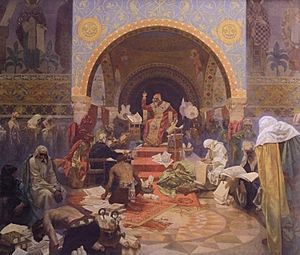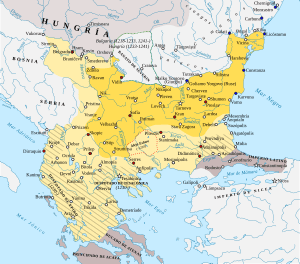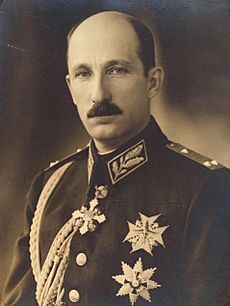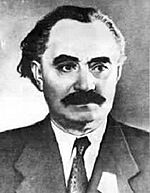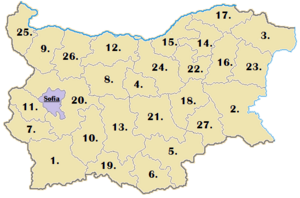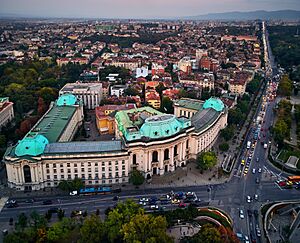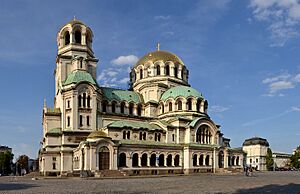Bulgaria facts for kids
Quick facts for kids
Republic of Bulgaria
|
|
|---|---|
![Location of Bulgaria (dark green)– on the European continent (green & dark grey)– in the European Union (green) — [Legend]](/images/thumb/e/e9/EU-Bulgaria.svg/250px-EU-Bulgaria.svg.png)
Location of Bulgaria (dark green)
– on the European continent (green & dark grey) |
|
| Capital and largest city
|
Sofia 42°41′51″N 23°19′21″E / 42.69750°N 23.32250°E |
| Official languages | Bulgarian |
| Official script | Cyrillic |
| Ethnic groups
(2021 census)
|
|
| Religion
(2021 census)
|
|
| Demonym(s) | |
| Government | Unitary parliamentary republic |
| Rumen Radev | |
| Iliana Iotova | |
| Rosen Zhelyazkov | |
| Legislature | National Assembly |
| Establishment history | |
| 681–1018 | |
| 1185–1396 | |
| 3 March 1878 | |
|
• Independence from the Ottoman Empire
|
5 October 1908 |
|
• Monarchy abolished
|
15 September 1946 |
| 15 November 1990 | |
| Area | |
|
• Total
|
110,993.6 km2 (42,854.9 sq mi) (103rd) |
|
• Water (%)
|
2.16 |
| Population | |
|
• December 2024 estimate
|
|
|
• 2021 census
|
|
|
• Density
|
58/km2 (150.2/sq mi) (154th) |
| GDP (PPP) | 2025 estimate |
|
• Total
|
|
|
• Per capita
|
|
| GDP (nominal) | 2025 estimate |
|
• Total
|
|
|
• Per capita
|
|
| Gini (2023) | ▼ 37.2 medium |
| HDI (2023) | very high · 55th |
| Currency | Lev (BGN) |
| Time zone | UTC+2 (EET) |
|
• Summer (DST)
|
UTC+3 (EEST) |
| Calling code | +359 |
| ISO 3166 code | BG |
| Internet TLD |
|
Bulgaria, also known as the Republic of Bulgaria, is a country located in Southeast Europe. It sits on the eastern part of the Balkans, south of the Danube river and west of the Black Sea. Bulgaria shares borders with Greece and Turkey to the south, Serbia and North Macedonia to the west, and Romania to the north.
Covering about 110,994 square kilometers, Bulgaria is one of the larger countries in the European Union. Its capital and largest city is Sofia. Other important cities include Burgas, Plovdiv, and Varna. Bulgaria has a rich history, with ancient cultures, powerful empires, and a journey to modern independence. Today, it is a member of the European Union and NATO.
Contents
What's in a Name? The Origin of "Bulgaria"
The name Bulgaria comes from the Bulgars. They were a tribe of Turkic origin who founded the First Bulgarian Empire. The exact meaning of their name is not fully known. It might come from an old Turkic word meaning "to mix" or "to stir." This could also mean "rebel" or "disturber."
Bulgaria's Journey Through Time
Ancient Times and Early Civilizations

The land of modern Bulgaria has been home to people for a very long time. Evidence of Neanderthals dates back about 150,000 years. The earliest modern humans arrived around 47,000 years ago. The Karanovo culture began around 6,500 BC. These early societies were skilled in agriculture.
Later, the Varna culture (around 5,000 BC) became famous for its gold work. They created the oldest golden jewelry in the world, over 6,000 years old! This treasure helps us understand ancient societies.
The Thracians were an important ancient group in the Balkan Peninsula. They were skilled in working with metals. They also influenced ancient Greek culture with their beliefs. The Roman Empire later took control of the region in AD 45. After the Roman Empire weakened, Slavic tribes settled in these lands around the 6th century.
The First Bulgarian Empire: A Powerful Beginning
In the late 7th century, the Bulgars, led by Khan Asparukh, arrived in the Balkans. They formed the First Bulgarian Empire in 681 AD. This empire became very powerful in the Balkans. It greatly influenced Slavic cultures.
One of its biggest achievements was developing the Cyrillic script. This alphabet is still used today in many countries. Important leaders like Krum and Simeon the Great expanded the empire. They made it a major power in Europe. The First Bulgarian Empire lasted until the early 11th century. Then, the Byzantine Empire conquered it.
The Second Bulgarian Empire: A Revival
After some time under Byzantine rule, a successful revolt in 1185 re-established the Bulgarian state. This was the Second Bulgarian Empire, with its capital at Tarnovo. It grew strong under leaders like Ivan Asen II. During his rule (1218–1241), the empire reached its largest size. Trade and culture flourished.
However, after many wars and internal conflicts, the empire became weaker. By the 14th century, it broke into smaller parts. These smaller states were then conquered by the Ottoman Turks.
Ottoman Rule and National Awakening
The Ottomans ruled Bulgarian lands for nearly 500 years, starting in 1396. During this time, Bulgarians faced high taxes and their culture was suppressed. Many educated people left the country. However, some monasteries kept Bulgarian identity alive.
As the Ottoman Empire weakened, other European powers became interested in the region. The Russian Empire supported Christians in Ottoman lands. This led to a national awakening of Bulgaria in the 18th century. Bulgarians began to seek their freedom.
A major uprising in 1876 was put down by the Ottomans. This led to the Russo-Turkish War of 1877–78. Russia, with the help of Bulgarian rebels, defeated the Ottomans. This war brought about the creation of the modern Bulgarian state.
Modern Bulgaria: Independence and Change
The Treaty of San Stefano in 1878 created a large Bulgarian principality. However, other European powers feared this large state. So, the Treaty of Berlin created a much smaller Principality of Bulgaria. This left many Bulgarians outside the new country's borders.
Bulgaria declared full independence from the Ottoman Empire in 1908. In the early 20th century, Bulgaria was involved in several conflicts. It allied with Germany in both World War I and World War II. During World War II, Bulgaria saved its Jewish population from deportation.
After World War II, Bulgaria became a socialist state under Soviet influence. The country focused on industrial growth. During this time, there were policies that required some minority groups to change their names, which led to many people moving to other countries.
In 1989, major changes swept across Eastern Europe. Bulgaria transitioned to a multiparty republic and a parliamentary democracy. The new system faced challenges in improving daily life and the economy at first. However, conditions improved greatly after 2001. Bulgaria joined NATO in 2004 and the European Union in 2007. It became a full member of the Schengen Area in January 2025.
Bulgaria's Natural Landscape
Bulgaria is a country of diverse landscapes in Southeast Europe. It covers about 110,994 square kilometers. Its borders with five neighboring countries stretch for 1,808 kilometers. The Black Sea coastline is 354 kilometers long.
Key natural features include the Danubian Plain, the Balkan Mountains, and the Upper Thracian Plain. The Balkan Mountains run across the middle of the country from west to east. The highest point in Bulgaria and the Balkans is Musala peak, standing at 2,925 meters. The Black Sea coast is the country's lowest point. Plains make up about one-third of the country, while plateaus and hills cover 41%.
Climate and Weather Patterns
Bulgaria has a varied climate due to its location. It's where Mediterranean, Oceanic, and Continental air masses meet. Mountains also play a role in shaping the weather. Northern Bulgaria is generally cooler and gets more rain than the southern regions.
Temperatures can vary a lot. The lowest recorded temperature was -38.3°C, and the highest was 45.2°C. Snowfall is common in winter, especially from continental air masses.
Rich Biodiversity and Conservation Efforts

Bulgaria is home to a wide variety of plants and animals, making it one of Europe's richest places for biodiversity. This natural wealth is protected in three national parks, 11 nature parks, 10 biosphere reserves, and 565 other protected areas.
You can find 93 of Europe's 233 mammal species here. Also, 49% of butterfly species and 30% of vascular plant species live in Bulgaria. In total, there are over 41,000 plant and animal species. Large mammals like deer, wild boar, and golden jackals have healthy populations. Forests cover about 36% of the country's land.
Bulgaria is committed to protecting its environment. It has adopted a National Biological Diversity Conservation Strategy. The country also has large Natura 2000 areas, covering over a third of its territory. Bulgaria is working to improve its air and water quality, as some areas face challenges from traffic and industry.
How Bulgaria is Governed
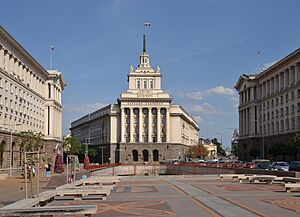
Bulgaria is a parliamentary democracy. This means citizens aged 18 and older can vote. The political system has three main parts: the legislative (making laws), executive (carrying out laws), and judicial (interpreting laws).
The Prime Minister is the head of the government and holds the most executive power. The President is the head of state and commander-in-chief of the armed forces. The President can send a bill back for more discussion, but Parliament can still pass it.
The National Assembly is where laws are made. It has 240 members, called deputies, who are elected for four-year terms. They approve the budget, choose the prime minister, and make important decisions for the country. Bulgaria has a multi-party system, and governments are often formed by coalitions of different parties. Rosen Zhelyazkov is the current Prime Minister, leading a government formed in January 2025. Natalia Kiselova was elected speaker of the National Assembly in December 2024.
Bulgaria is a free country with a democratic system. There are ongoing efforts to improve how the government works and ensure fairness for everyone.
Laws and Justice in Bulgaria
Bulgaria uses a civil law legal system. The Ministry of Justice oversees the courts. The highest courts are the Supreme Administrative Court and the Supreme Court of Cassation. They make sure laws are applied correctly. The Supreme Judicial Council manages the system and appoints judges. Bulgaria has a legal system that works to uphold laws and ensure justice. Like many countries, it continuously works to improve its transparency and efficiency.
Law enforcement is handled by the Ministry of the Interior. The General Directorate of National Police (GDNP) deals with general crime and keeps public order. The Ministry also leads the Border Police Service and the National Gendarmerie. These specialized groups handle anti-terrorist activities and crisis management.
How Bulgaria is Divided
Bulgaria is a unitary state, meaning the central government has most of the power. It is divided into 27 provinces and a metropolitan capital province (Sofia City). Each province is named after its main city.
These provinces are further divided into 265 municipalities. Mayors, elected for four-year terms, run the municipalities. They also have directly elected municipal councils. The central government plays a big role in funding and managing these local areas.
Bulgaria's Place in the World

Bulgaria joined the United Nations in 1955. It has also been a non-permanent member of the Security Council three times. Since the fall of communism, joining the European Union and NATO has been a top goal.
Bulgaria became a full member of the European Union on January 1, 2007. It also joined NATO in March 2004. These memberships have strengthened its international relationships. Bulgaria also has good ties with countries like China, Vietnam, and Russia.
In 2001, foreign troops were stationed in Bulgaria for the first time since World War II. This was to support efforts in Afghanistan. Later, the US and Bulgaria signed a defense agreement. This created joint military training facilities. Despite its active international defense work, Bulgaria is considered one of the most peaceful countries globally.
The Bulgarian Armed Forces
The Bulgarian Armed Forces protect the country. They include land forces, a navy, and an air force. There are about 36,950 active troops and 3,000 reservists. The military is modernizing its equipment. It is acquiring new F-16 fighter jets and other modern NATO-standard gear.
Bulgaria's Economy
Bulgaria has an open market economy. The private sector makes up more than 70% of the country's economic activity. In the 1980s, Bulgaria transformed from an agricultural country into an industrial one.
After some economic challenges in the 1990s, the economy recovered with rapid growth. The average salary is growing, but still lower than some other EU countries. Bulgaria achieved a balanced budget in 2003. It has some of the lowest corporate income tax rates in the EU, at a flat 10%.
The Yugozapaden region, which includes the capital city Sofia, is the most developed area. It generates 42% of the national economic output. The Bulgarian National Bank issues the national currency, the lev, which is linked to the euro.
Key Industries and Services
Bulgaria's workforce includes 3.36 million people. About 6.8% work in agriculture, 26.6% in industry, and 66.6% in services. Major industries include metal and mineral extraction, chemicals, machine building, and food processing. Mining is important, employing 24,000 people. Bulgaria is Europe's fifth-largest coal producer.
In agriculture, grains like maize, barley, and rice are grown. Quality Oriental tobacco is also a significant crop. Bulgaria is the world's largest producer of lavender and rose oil, used in fragrances.
Tourism is a big part of the services sector. Popular places to visit include Sofia, Plovdiv, Veliko Tarnovo, and coastal resorts like Sunny Beach. Winter resorts like Bansko also attract many visitors.
Science, Technology, and Space
Bulgaria invests in research and development. The Bulgarian Academy of Sciences (BAS) receives most public funding. Private businesses also contribute a lot to research. Bulgaria is known for strong research in chemistry, materials science, and physics.
Bulgaria has made many contributions to space exploration. It has launched scientific satellites and sent two cosmonauts into space. Bulgaria was the first country to grow wheat in space on the Mir space station. Bulgarian instruments have also been used in the exploration of Mars. In 2017, Bulgaria launched its first geostationary communications satellite, BulgariaSat-1, with SpaceX.
Connecting Bulgaria: Infrastructure
Telephone services are widely available across Bulgaria. Internet access is also common, with 78.9% of households having it in 2020.
Bulgaria's location and energy sector make it an important energy hub in Europe. Thermal power plants generate 48.9% of electricity. Nuclear power from the Kozloduy reactors provides 34.8%, and renewable sources contribute 16.3%. Bulgaria produces more electricity than it needs, so it can export energy.
The country has a large road network, with most roads paved. Railroads are important for moving goods. Sofia is the main hub for air travel. Varna and Burgas are the main ports for sea trade.
People and Population
Ethnic groups in Bulgaria (2021 census) Bulgarians (84.57%) Turks (8.40%) Romani (4.41%) Others (1.31%) Undeclared (1.31%)
As of 2022, Bulgaria's population is about 6.4 million people. Most of the population (72.5%) lives in cities. Sofia is the largest city, followed by Plovdiv, Varna, Burgas, and Ruse.
Bulgarians are the largest ethnic group, making up 84.6% of the population. There are also significant Turkish (8.4%) and Roma (4.4%) minorities. Bulgaria's population has seen changes over the years, with some people moving to other countries. Bulgaria is working to encourage families and support its population.
Bulgaria scores high in gender equality. Women have equal political rights and high participation in the workforce. In 2021, Bulgaria was ranked as one of the best European countries for women to work.
Largest Cities in Bulgaria
|
Largest cities or towns in Bulgaria
2021 Census |
||
|---|---|---|
| Rank | Name | Pop. |
| 1 | Sofia | 1,190,256 |
| 2 | Plovdiv | 321,824 |
| 3 | Varna | 311,093 |
| 4 | Burgas | 188,242 |
| 5 | Ruse | 123,134 |
| 6 | Stara Zagora | 121,582 |
| 7 | Pleven | 90,209 |
| 8 | Sliven | 79,362 |
| 9 | Dobrich | 71,947 |
| 10 | Shumen | 67,300 |
Health and Well-being
Bulgaria's healthcare system is working to meet the needs of its people, especially as the population ages. There are efforts to improve access to care and support medical professionals. The average life expectancy in Bulgaria is 74.8 years.
Learning and Education
Bulgaria's education system provides free and compulsory schooling. It includes 12 grades, with primary school from grades one to eight and secondary school from nine to twelve. Higher education offers bachelor's and master's degrees. The Sofia University is Bulgaria's highest-ranked university.
Basic literacy in Bulgaria is very high, at 98.4%. This means almost everyone can read and write. Bulgaria is working to improve learning outcomes for all students.
The Bulgarian Language
Bulgarian is the official language of the country. It belongs to the Slavic group of languages. It has some unique grammar features, like not using noun cases or infinitives. It also uses a definite article at the end of words.
Faith and Beliefs
Bulgaria is a secular state, meaning there is freedom of religion. However, Eastern Orthodox Christianity is considered the traditional religion. About two-thirds of Bulgarians identify as Eastern Orthodox Christians. The Bulgarian Orthodox Church was one of the first national churches to gain independence in 927 AD.
Muslims are the second-largest religious group, making up about 10% of the population. Other religions include Roman Catholicism, Judaism, and various Protestant faiths. A growing number of Bulgarians do not identify with any religion.
Bulgarian Culture and Traditions
Bulgarian culture is a mix of ancient folk traditions and modern influences. Fire is an important element in folklore, used to ward off evil spirits. Rituals like kukeri and survakari are still practiced today. Martenitsa is also a widely celebrated tradition.
Nestinarstvo, a fire-dance of Thracian origin, is recognized by UNESCO. Nine historical and natural sites in Bulgaria are UNESCO World Heritage Sites. These include Pirin National Park and the Rila Monastery.
Bulgarian literature has a rich history. The Preslav and Ohrid literary schools were important in the Middle Ages. They helped spread the Cyrillic alphabet and Christian writings. Famous modern writers include Ivan Vazov and Aleko Konstantinov.
Visual arts also have a long tradition, with frescoes and icons from medieval times. Artists like Zahari Zograf and Vladimir Dimitrov captured Bulgarian life. Christo is a famous Bulgarian artist known for his large outdoor installations.
Folk music is a very important part of Bulgarian culture. It has a unique sound, blending different musical styles. Traditional instruments include the gadulka and gaida. The Bulgarian State Television Female Vocal Choir even won a Grammy Award for its folk music. Modern classical music also has famous composers and singers.
Bulgarian cuisine is similar to other Balkan foods, with Turkish and Greek influences. Popular dishes include yogurt, banitsa, and shopska salad. Bulgaria is also known for its Bulgarian wine and traditional fruit brandy called Rakia.
Sports and Achievements

Bulgaria has a strong history in sports. Bulgarian athletes have won many medals at the Olympic Games. Weightlifting and wrestling are especially successful sports for Bulgaria.
Stefka Kostadinova holds the world record in women's high jump, set in 1987. Grigor Dimitrov is a well-known Bulgarian tennis player.
Football is the most popular sport. The Bulgaria national football team achieved 4th place at the 1994 FIFA World Cup. Hristo Stoichkov, a famous Bulgarian player, was a top goalscorer in that tournament. Clubs like CSKA Sofia and Levski Sofia are very popular.
See also
 In Spanish: Bulgaria para niños
In Spanish: Bulgaria para niños
- Outline of Bulgaria
- Labour law in Bulgaria




